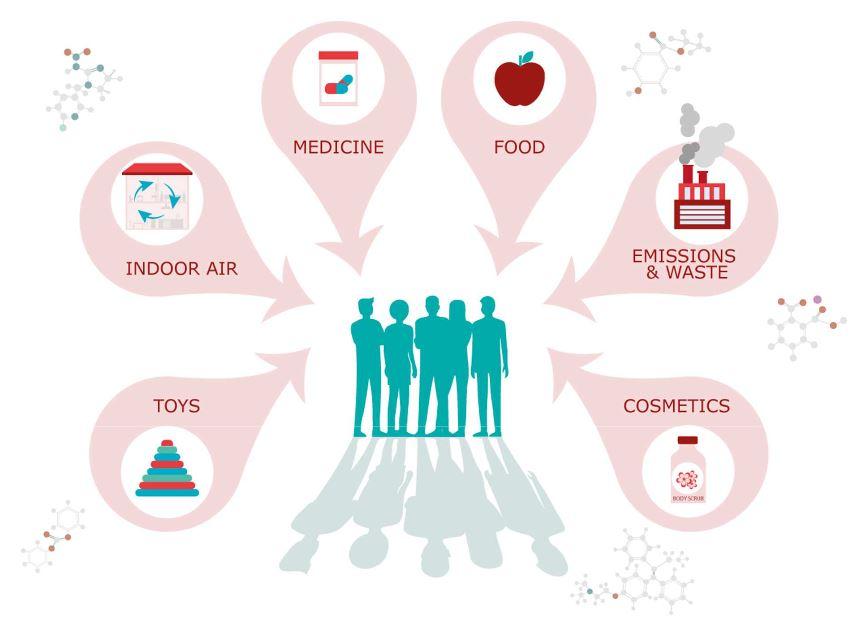
Every day we are exposed to low levels of hundreds of different manmade chemicals present for example in our food, consumer products and the air we breathe.
Our environment too is exposed to a near-infinite number of chemical mixtures derived from numerous sources.
However, current safety assessment practice is primarily based on understanding the potential risk posed by single substances rather than their "real life" combinations, thus potential combination effects might be overlooked.
The JRC is investigating recent progress in considering combined exposures to multiple chemicals to help translate best science into best assessment practice. The latest policy brief, Something from nothing? Ensuring the safety of chemical mixtures, puts together issues around the topic, including the specific challenges that will further inform discussions of the working group of Commission services and EU agencies on the combination effects of chemicals.
The 'mixtures' issue
Combined exposure to multiple chemicals can lead to adverse effects on human health or the ecosystem, even if single substances in the mixtures are below their individual safety thresholds.
The assessment and management of chemical mixtures is only partly covered by current legislation, which focuses mostly on single substances.
In particular, while manufactured products such as pesticide formulations or cosmetic products are covered, unintentional mixtures which are coincidentally formed such as mixtures of contaminants e.g. in indoor air, are not consistently addressed.
Their composition is often unknown and changes over time, making them difficult to regulate. The assessment of unintentional mixtures is therefore usually limited to specific legislative sectors only, such as pesticide residues in food.
Assessment of chemical mixtures now
Different methods are already being used to predict or assess mixture toxicity.
Chemical mixtures are assessed either by testing the whole mixture (e.g. in effect-based monitoring of surface water) or by predicting the combined risk based on concentration and effect information of the individual components in the mixture (e.g. in the assessment of dioxins and dioxin-like compounds in food and feed).
With a view to harmonising assessment methodology, international bodies, such as the World Health Organisation (WHO) and the Organisation for Economic Cooperation and Development (OECD) have developed guidance on the assessment of risks from combined exposure to multiple chemicals.
However, there are still many gaps concerning availability and interpretation of data, and there is no harmonised assessment approach across different sectors of legislation.
Toxicity assessment of mixtures in the future
The JRC has been analysing the available methodologies for chemicals testing. Due to the large number of chemical combinations, it is practically unfeasible to test all possible mixtures experimentally, in particular in animal studies for ethical and practical reasons.
Therefore smart strategies are needed to address the data gaps and to assess the potential hazards using new tools that rely less on in vivo testing and incorporate instead alternative experimental and computational tools.
Their main strengths lie in their integrated use in smart combinations, allowing a better, mechanistically based prediction of mixture effects.
JRC activities on mixtures
The JRC is performing research on the use of alternative (non-animal) methods and new strategies to assess the combination effects of chemicals.
Having reviewed current EU regulatory requirements and mixture assessment practices, it is currently exploring links between mixtures and possible subsequent diseases, interaction effects of chemicals, as well as the use of biomonitoring data in exposure assessment.
At the same time, chemical monitoring data is becoming more consistently available via the EC Information Platform for Chemical Monitoring IPCHEM, hosted by the JRC.
Progress through collaboration
The JRC collaborates with five European research consortia focusing on chemical mixture assessment for the environment (SOLUTIONS), human health (EuroMix, HBM4EU), endocrine disruption (EDC-MixRisk) and alternatives to animal testing (EUToxRisk).
The JRC also facilitates and provides scientific input to discussions with EU Commission services and regulatory agencies, European Food Safety Authority (EFSA), European Environmental Agency (EEA) and European Chemicals Agency (ECHA).
Furthermore, the JRC is actively involved in international initiatives under the auspices of the OECD and the WHO.
In a joint effort, the above-mentioned research projects together with representatives from the Commission services and European agencies, organised a joint Horizon2020 workshop "Advancing the Assessment of Chemical Mixtures and their Risks for Human Health and the Environment”, which was hosted by JRC Ispra, at the end of May 2018.
Experts in the field of chemical mixtures gathered to discuss the current state of knowledge as well as further elaborate and prioritise areas for future policy and research needs.
Background
In 2012, the Commission Communication on "Combined effects of chemicals – chemical mixtures" identified several gaps and areas for action.
The JRC has gathered information about current regulatory requirements and available guidance and about current practices in assessing mixtures and developed the Information Platform for Chemical Monitoring (IPCHEM).
Relevant sector-specific developments, EU research projects and activities of international organisations were also taken into account.
Related Content
JRC policy brief: Something from nothing? Ensuring the safety of chemical mixtures
News: Towards improved safety assessment of combined exposure to chemicals
Report: Assessment of Mixtures - Review of Regulatory Requirements and Guidance
Report: Review of case studies on the human and environmental risk assessment of chemical mixtures
Details
- Publication date
- 28 June 2018
